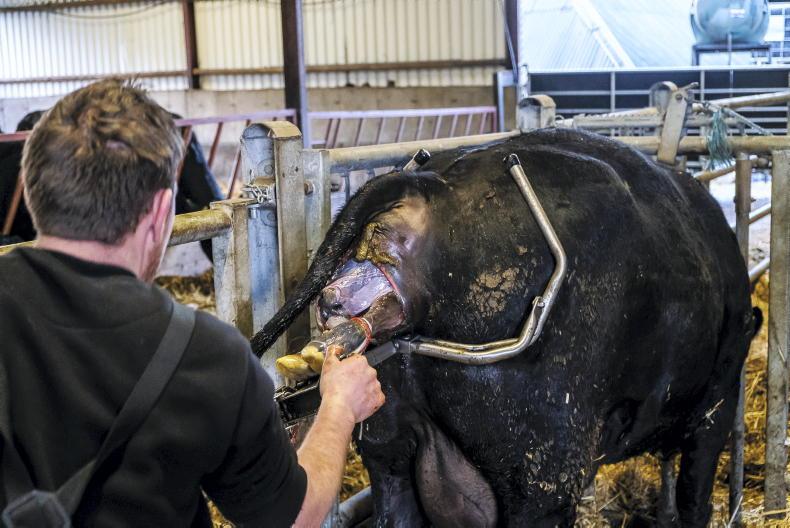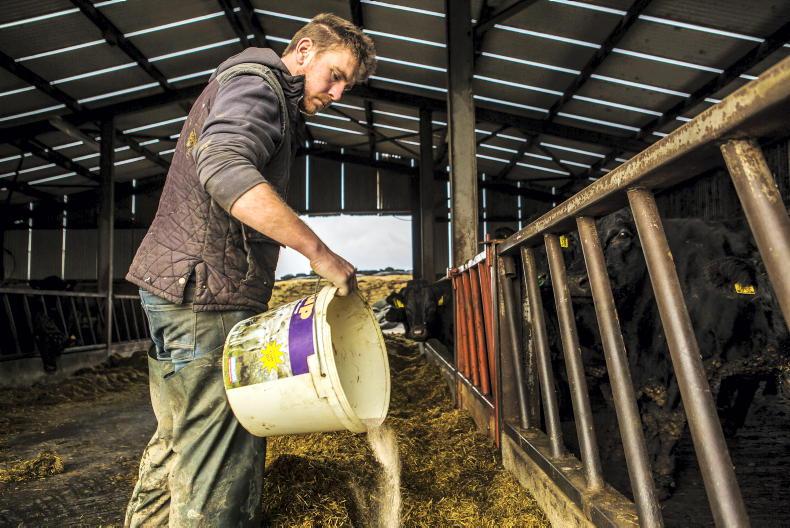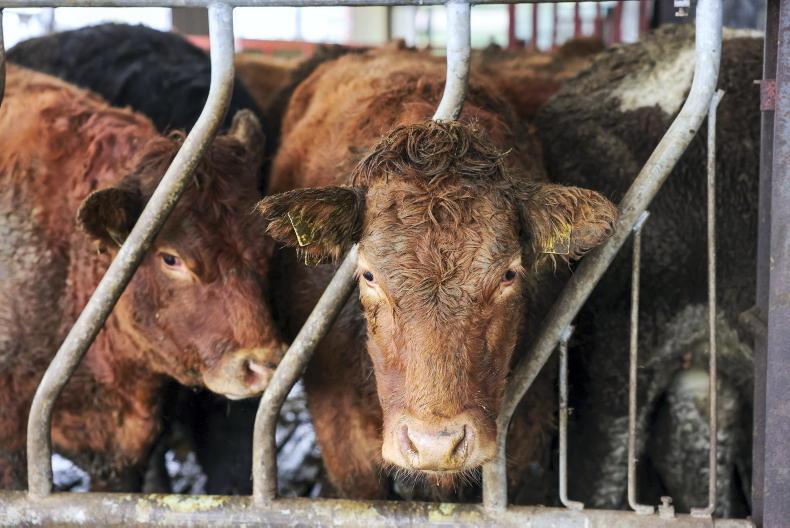Correct use of calving aids will increase the prospects of getting live calves on the ground.
While most cows will calve unassisted, on the occasions that aids are required, it is important that farmers can use them properly.
Outlined are some tips to make best use of calving aids.
1 Gloves and calving lubricant
Any time you intervene to check on the position of a calf or to assist its delivery, always wear a glove and use some form of obstetric lubricant.
Arm-length plastic gloves can reduce the farmer’s grip when pulling legs or calving ropes.
A good tip to increase traction is to wear a latex hand glove over the top of the plastic glove.
A proper calving lubricant is recommended, as it is less likely to dry out when applied.
Many calving lubricants will have antibacterial properties also.
Never use household soaps or washing up liquids, as these are irritants and will dry out.
Applying lubricant by hand inside the cow’s vagina and around the calf’s head is straightforward.
Getting lubricant further inside the birth canal when the calf is present is much more difficult.
A good tip is to use a large syringe with a piece of flexible piping from an old stomach tube attached.
The piping can be fed past the calf’s shoulders and lubricant can then be discharged further inside the cow.
2 Double-loop the calving ropes
When attaching leg ropes, place the first loop above the calf’s fetlock, then place a second loop below the fetlock.

Placing a second loop below the fetlock can spread the pressure exerted by calving ropes under tension.
The second loop will spread the pressure applied by hand or jack, reducing the risk of breaking the calf’s leg.
Always make sure the loop knots are positioned on the underside of the calf’s leg.
3 Calving jack
If the calf is the correct birthing position, the calving jack should only be applied when the calf’s eyes are visible.
Pulling with the jack at an earlier stage increases the risk of the calf getting stuck, as the cow may not be fully dilated or the calf may have big shoulders.
Position the jack so it rests on the pelvis, attach the ropes and take up the slack.
At the correct tension, both ropes should touch when squeezed together by hand.
The ratchet should always be worked in a smooth action, levering the bar down as the cow pushes, then taking up the slack when she relaxes.
In a prolonged labour and the calf’s head and shoulders are out, release the rope tension at regular intervals to allow the calf to breathe.
Continually stretching the calf out increases the risk of the animal dying.
4 Head ropes
Head ropes can be a useful aid when used properly, but can be a hindrance in the wrong hands.
Never attach the head rope to the jack.
It should only be pulled by hand with equal pressure on both ends of the rope.
Position the rope around the back of the head, under the ears and feed it back around below the chin.
Do not place the rope through the calf’s jaw. Pulling the rope in this position will cause the jaw to fracture.
5 Stomach tube
Calves delivered during a hard labour will most likely need assistance to feed.
First off, try feeding the calf on a bottle and teat first to stimulate the suckling reflex.

Always use a sterile stomach tube to feed calves. Flushing boiling water through the tube will make it more flexible and easier to insert in the calf's stomach. Never use the same tube for healthy and sick calves.
If the stomach tube is necessary, make sure it has been sterilised.
Flushing boiling water through the tube before use will make the pipe more pliable and easier to place into the calf’s stomach.
When working on your own, inserting a stomach tube can be awkward.
Tying the top of the bag to a gate will free up your hands for holding the calf and feeding the tube down the throat correctly.
Never use the same stomach tube for sick and healthy calves. Sick calves should always have a separate tube.
Read more
Watch: calving webinar – your questions answered
Spring calving series: click for tips and advice
Correct use of calving aids will increase the prospects of getting live calves on the ground.
While most cows will calve unassisted, on the occasions that aids are required, it is important that farmers can use them properly.
Outlined are some tips to make best use of calving aids.
1 Gloves and calving lubricant
Any time you intervene to check on the position of a calf or to assist its delivery, always wear a glove and use some form of obstetric lubricant.
Arm-length plastic gloves can reduce the farmer’s grip when pulling legs or calving ropes.
A good tip to increase traction is to wear a latex hand glove over the top of the plastic glove.
A proper calving lubricant is recommended, as it is less likely to dry out when applied.
Many calving lubricants will have antibacterial properties also.
Never use household soaps or washing up liquids, as these are irritants and will dry out.
Applying lubricant by hand inside the cow’s vagina and around the calf’s head is straightforward.
Getting lubricant further inside the birth canal when the calf is present is much more difficult.
A good tip is to use a large syringe with a piece of flexible piping from an old stomach tube attached.
The piping can be fed past the calf’s shoulders and lubricant can then be discharged further inside the cow.
2 Double-loop the calving ropes
When attaching leg ropes, place the first loop above the calf’s fetlock, then place a second loop below the fetlock.

Placing a second loop below the fetlock can spread the pressure exerted by calving ropes under tension.
The second loop will spread the pressure applied by hand or jack, reducing the risk of breaking the calf’s leg.
Always make sure the loop knots are positioned on the underside of the calf’s leg.
3 Calving jack
If the calf is the correct birthing position, the calving jack should only be applied when the calf’s eyes are visible.
Pulling with the jack at an earlier stage increases the risk of the calf getting stuck, as the cow may not be fully dilated or the calf may have big shoulders.
Position the jack so it rests on the pelvis, attach the ropes and take up the slack.
At the correct tension, both ropes should touch when squeezed together by hand.
The ratchet should always be worked in a smooth action, levering the bar down as the cow pushes, then taking up the slack when she relaxes.
In a prolonged labour and the calf’s head and shoulders are out, release the rope tension at regular intervals to allow the calf to breathe.
Continually stretching the calf out increases the risk of the animal dying.
4 Head ropes
Head ropes can be a useful aid when used properly, but can be a hindrance in the wrong hands.
Never attach the head rope to the jack.
It should only be pulled by hand with equal pressure on both ends of the rope.
Position the rope around the back of the head, under the ears and feed it back around below the chin.
Do not place the rope through the calf’s jaw. Pulling the rope in this position will cause the jaw to fracture.
5 Stomach tube
Calves delivered during a hard labour will most likely need assistance to feed.
First off, try feeding the calf on a bottle and teat first to stimulate the suckling reflex.

Always use a sterile stomach tube to feed calves. Flushing boiling water through the tube will make it more flexible and easier to insert in the calf's stomach. Never use the same tube for healthy and sick calves.
If the stomach tube is necessary, make sure it has been sterilised.
Flushing boiling water through the tube before use will make the pipe more pliable and easier to place into the calf’s stomach.
When working on your own, inserting a stomach tube can be awkward.
Tying the top of the bag to a gate will free up your hands for holding the calf and feeding the tube down the throat correctly.
Never use the same stomach tube for sick and healthy calves. Sick calves should always have a separate tube.
Read more
Watch: calving webinar – your questions answered
Spring calving series: click for tips and advice











SHARING OPTIONS